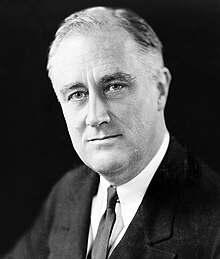
Executive Order 8389 Protecting Funds of Victims of Aggression [1] was issued by U.S. President Franklin D. Roosevelt on April 10, 1940, following the invasions of Denmark and Norway by Nazi Germany.

Executive Order 8389 Protecting Funds of Victims of Aggression [1] was issued by U.S. President Franklin D. Roosevelt on April 10, 1940, following the invasions of Denmark and Norway by Nazi Germany.
One of the primary concerns of the U.S. government in the early years of World War II was to prevent the Nazis from using the financial resources of the United States to finance their military campaigns and occupation costs. [2] The task of enforcing this goal by controlling financial assets fell to the US Treasury Department, and President Roosevelt enabled its actions by issuing Executive Order 8389 on April 10, 1940, which froze Norwegian and Danish assets in the United States. As precedent, Roosevelt invoked an act of October 6, 1917, and Executive Order 6560 of January 15, 1934. [3]
In doing so, Roosevelt not only offered symbolic support to the occupied nations of Europe, but also guaranteed future practical assistance by assuring that the assets of such states would be returned once the aggressors were defeated. [4] : 34 The Order, initially ruling only on Norwegian and Danish assets, was later amended to include those of most European states, with the notable exemption of Great Britain. The subsequent amendments were filed under separate Order numbers. [5]
After the occupation and annexation of the Baltic States (Estonia, Latvia and Lithuania) by the Soviet Union, Order 8389 was amended via Executive Order 8484 on 15 July 1940 to include those states. [6] The Soviet government condemned the freezing of the Baltic states' assets, asserting that there was no legal basis for suspending the transfer. [4] : 35 Sumner Welles, acting Secretary of State, addressed the objection in a statement:
The attempt to transfer the gold belonging to the Banks of Lithuania, Latvia, and Estonia was made at a time when it had become apparent that the governments and peoples of those countries were being deprived of freedom of action by foreign troops which had entered their territories by force or threats of force. [4] : 35
Prior to the inclusion of Estonia, Latvia, and Lithuania, all the other European states affected by the Order had come under the military occupation of Nazi Germany. [4] : 35 In conjunction with the Welles declaration, Executive Order 8484 and its enforcement by the Treasury Department offered both immediate and long-term benefits to the Baltic states. [4] : 42
A postcard was sent in 1940 by a German Company in Germany to a firm in New York. In the postcard there is a mention of Munich Reich Bank, that triggered application of this Roosevelt Executive order. Upon arrival to the US this marking was added: "SUPPOSED TO CONTAIN MATTER SUBJECT TO THE PROVISIONS OF EXECUTIVED ORDER 8389 AS AMENDED." The German firm was Wackerchemic of Munich and the PC was sent to Sager & Malcolm in NYC.

The Baltic states or the Baltic countries is a geopolitical term encompassing Estonia, Latvia, and Lithuania. All three countries are members of NATO, the European Union, the Eurozone, Council of Europe, and the OECD. The three sovereign states on the eastern coast of the Baltic Sea are sometimes referred to as the "Baltic nations", less often and in historical circumstances also as the "Baltic republics", the "Baltic lands", or simply the Baltics. The term Balticum is sometimes used to describe the region comprising the three states.

The Trading with the Enemy Act (TWEA) of 1917 is a United States federal law, enacted on October 6, 1917, in response to the United States declaration of war on Germany on April 6, 1917. It continues to give the President of the United States the power to oversee or restrict any and all trade between the United States and its enemies in times of war. TWEA was amended in 1933 by the Emergency Banking Act to extend the president’s authority also in peace time. It was amended again in 1977 by the International Emergency Economic Powers Act (IEEPA) to restrict again the application of TWEA only to times of war, while the IEEPA was intended to be used in peace time.
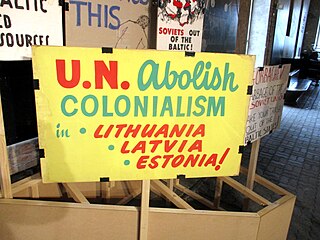
The occupation of the Baltic states was a period of annexation of Estonia, Latvia and Lithuania by the Soviet Union from 1940 until its dissolution in 1991. For a brief period, Nazi Germany occupied the Baltic states after it invaded the Soviet Union in 1941.

The Latvian diplomatic service in exile was the only governmental body of the Republic of Latvia which continued its activities during the Nazi and Soviet occupation of Latvia during 1940–1991. Latvian diplomats who were stationed in embassies and consulates at the moment of the occupation in 1940, refused to recognize the occupation and return to Soviet Latvia. They continued to formally represent the interests of Latvia in countries that did not recognize the Soviet annexation. After the restoration of Latvian independence in 1991, the diplomats started reporting to the restored Latvian Ministry of Foreign Affairs.

The Baltic Way or Baltic Chain was a peaceful political demonstration that occurred on 23 August 1989. Approximately two million people joined their hands to form a human chain spanning 690 kilometres (430 mi) across the three Baltic states of Estonia, Latvia and Lithuania, which at the time were occupied and annexed by the USSR and had a combined population of approximately eight million. The central government in Moscow considered the three Baltic countries constituent republics of the Soviet Union.

After the German invasion of the Soviet Union, the Baltic states were under military occupation by Nazi Germany from 1941 to 1944. Initially, many Estonians, Latvians, and Lithuanians considered the Germans liberators from the Soviet Union.
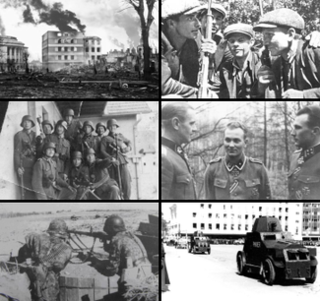
Estonia declared neutrality at the outbreak of World War II (1939–1945), but the country was repeatedly contested, invaded and occupied, first by the Soviet Union in 1940, then by Nazi Germany in 1941, and ultimately reinvaded and reoccupied in 1944 by the Soviet Union.

The three Baltic countries, or the Baltic states – Estonia, Latvia, and Lithuania – are held to have continued as independent states under international law while under Soviet occupation from 1940 to 1991, as well as during the German occupation in 1941–1944/1945. The prevailing opinion accepts the Baltic thesis that the Soviet occupation was illegal, and all actions of the Soviet Union related to the occupation are regarded as contrary to international law in general and to the bilateral treaties between the USSR and the three Baltic countries in particular.
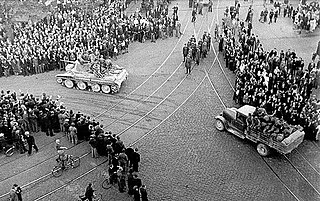
The Soviet occupation of Latvia in 1940 refers to the military occupation of the Republic of Latvia by the Soviet Union under the provisions of the 1939 Molotov–Ribbentrop Pact with Nazi Germany and its Secret Additional Protocol signed in August 1939.
The Select Committee to Investigate Communist Aggression and the Forced Incorporation of the Baltic States into the U.S.S.R., also known as the Kersten Committee after its chairman, U.S. Representative Charles J. Kersten was established in 1953 to investigate the annexation of Estonia, Latvia, and Lithuania into the Soviet Union. The committee terminated March 4, 1954, when it was replaced by the Select Committee on Communist Aggression.

The Soviet re-occupation of Latvia in 1944 refers to the military occupation of Latvia by the Soviet Union in 1944. During World War II Latvia was first occupied by the Soviet Union in June 1940, then was occupied by Nazi Germany in 1941–1944, and after which it was re-occupied by the Soviet Union.

Relevant events began regarding the Baltic states and the Soviet Union when, following Bolshevist Russia's conflict with the Baltic states—Lithuania, Latvia and Estonia—several peace treaties were signed with Russia and its successor, the Soviet Union. In the late 1920s and early 1930s, the Soviet Union and all three Baltic States further signed non-aggression treaties. The Soviet Union also confirmed that it would adhere to the Kellogg–Briand Pact with regard to its neighbors, including Estonia and Latvia, and entered into a convention defining "aggression" that included all three Baltic countries.
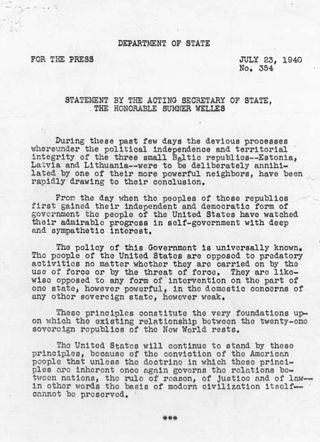
The Welles Declaration was a diplomatic statement issued on July 23, 1940, by Sumner Welles, the acting US Secretary of State, condemning the June 1940 occupation by the Soviet army of the three Baltic countries – Estonia, Latvia, and Lithuania – and refusing to diplomatically recognize their subsequent annexation into the Soviet Union. It was an application of the 1932 Stimson Doctrine of nonrecognition of international territorial changes that were executed by force and was consistent with US President Franklin Roosevelt's attitude towards violent territorial expansion.
The timeline of the occupation of the Baltic states lists key events in the military occupation of the three countries – Estonia, Latvia and Lithuania – by the Soviet Union and by Nazi Germany during World War II.
Executive Order 8484, issued on July 10, 1940, by U.S. President Franklin D. Roosevelt, was one of a series of amendments to Executive Order 8389.
The Sovietization of the Baltic states is the sovietization of all spheres of life in Estonia, Latvia and Lithuania when they were under control of the Soviet Union. The first period deals with the occupation from June 1940 to July 1941, followed by the German occupation during World War II. The second period of occupation covers 1944 when the Soviet forces pushed the Germans out, until the end of the Soviet occupation in 1991 when the three countries restored full independence.

The background of the occupation of the Baltic states covers the period before the first Soviet occupation on 14 June 1940, stretching from independence in 1918 to the Soviet ultimatums in 1939–1940. Lithuania, Latvia, and Estonia gained independence in the aftermath of the Russian revolutions of 1917 and the German occupation which in the Baltic countries lasted until the end of World War I in November 1918. All three countries signed non-aggression treaties with the Soviet Union in the 1920s and 1930s. Despite the treaties, in the aftermath of the 1939 German–Soviet pact, Estonia, Latvia and Lithuania were occupied, and thereafter forcibly incorporated into the Soviet Union, in 1940.

The Soviet occupation of the Baltic states covers the period from the Soviet–Baltic mutual assistance pacts in 1939, to their invasion and annexation in 1940, to the mass deportations of 1941.

The Soviet Union (USSR) occupied most of the territory of the Baltic states in its 1944 Baltic Offensive during World War II. The Red Army regained control over the three Baltic capitals and encircled retreating Wehrmacht and Latvian forces in the Courland Pocket where they held out until the final German surrender at the end of the war.

The guerrilla war in the Baltic states was an insurgency waged by Baltic partisans against the Soviet Union from 1944 to 1956. Known alternatively as the "Forest Brothers", the "Brothers of the Wood" and the "Forest Friars", these partisans fought against invading Soviet forces during their occupation of the Baltic states during and after World War II. Similar insurgent groups resisted Soviet occupations in Bulgaria, Poland, Romania and Ukraine.
Whereas on July 15, 1940, President Franklin D. Roosevelt issued Executive Order No. 8484, which froze Baltic assets in the United States to prevent them from falling into Soviet hands